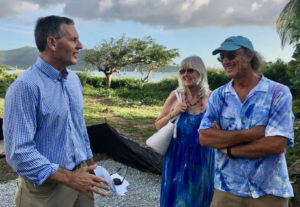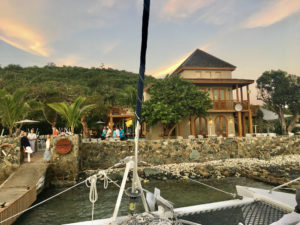
During its first three weeks in business in February, Lovango Resort & Beach Club transported 2,336 passengers to dine at ZoZo’s H20, the only facility currently open at the fledgling island resort.
These passengers arrived by reserved ferry service, according to the resort’s co-owner Mark Snider. He said an unknown number of guests also came by private and charter vessels, particularly on the weekends.
Snider provided this information at a public hearing held by the St. John Committee of Coastal Zone Management at the Legislative Annex in Cruz Bay Tuesday night.
The hearing was intended to serve two purposes – first, to consider changing the zoning on Lovango Cay from R-1 (low density residential) to a Planned Area Development; second, to serve as a Coastal Zone Management permitting hearing required before the next phases of development can begin.
The meeting began with an overview of the plans for the resort which is being built on approximately 45 acres of the 118-acre cay. The island is located in Pillsbury Sound about two miles northwest of Cruz Bay.
Most of the island’s remaining 70-plus acres are owned by ancestral St. John families. Although several members of these families attended the hearing, none chose to speak publicly.
ZoZo’s H20, under the direction of noted restauranteur John Ferrigno, opened on Feb. 6, only five days after the date originally set in November 2019 when the sale of the property was completed. The restaurant is intended to attract boating excursion guests who typically travel to the British Virgin Islands. In the past year, the BVI has raised port fees, causing USVI-based boaters to look for waterfront destinations closer to home.

Sixteen percent of the guests so far have been full-time Virgin Islands residents, taking advantage of a local ferry service discount, according to Snider. ZoZo’s H2O has been a huge success, according to postings on social media and word of mouth. Many diners have publicly praised the restaurant’s island-time ambiance and excellent cuisine.
Lovango Cay Resort & Beach Club is owned by the Snider family, which includes Mark, his wife Gwen, and his son Matt. Matt and Django Broer-Hellermann are overseeing construction on Lovango Cay. The developers have ambitious plans, at least in terms of timing.
By December 2020, the Sniders intend to open the beach club portion of the development which will include three pools, cabanas, an addition to the restaurant, a non-motorized water sports rental outlet, and a kiosk for the sale of local crafts.
In December 2021, the owners hope to complete construction of four clusters of cottages and/or eco-tents that will eventually total 70 separate bedroom units. From 2022 to 2024, the remaining cottages will be built.
At the hearing, an audience member questioned a discrepancy in the timeline presented that evening compared to the one outlined in the permit application to CZM. Snider said they initially planned to complete construction in a shorter time frame, but the reality of obtaining building materials and transporting them by small barge made them adjust their plans.
As the cottages are being constructed, the owners plan to sell 14 lots to private owners to build homes which may be included in the resort’s rental pool or kept for private use. The private homes will have to comply with standards set by the Lovango Cay Homeowners Association.
At this point, the developers intend to build the resort cottages on the north side of Lovango Cay, and sell property for private home sites on the south and east sides of the island. Several times during the hearing, Snider said he would comply with restrictions to limit height of buildings to two stories so that roof lines would not exceed the ridge line.
Snider also said the developers would install silt fencing during construction to prevent sediment runoff and design low-impact lighting that adheres to “dark sky” standards.
Lovango Cay Resort came under fire several weeks ago on social media for allowing boaters to anchor off shore in shallow water resulting in damage to coral reefs. Snider said the resort had recently installed six moorings and has applied to the Department of Planning and Natural Resources to install an additional ten moorings.

STJ-CZM member Brion Morrisette, who owns a home on Lovango Cay, said he was concerned about prop-wash from vessels that could damage marine life. He asked Snider to set restrictions on how long boats using the resort’s dock could run their engines.
When Morrisette asked Snider if he would agree to a no-anchoring policy to further protect the coral reefs, Snider said he would do his best to have boats adhere to such a policy, then added, “I’m not sure we have the legal right to tell people where to anchor.”
Amy Dempsy, the owner of Bio-Impact, an environmental consulting firm, said the Department of Planning and Natural Resources has the authority to establish and enforce a no-anchoring zone.
STJ-CZM member David Silverman said he would prefer to see the resort develop a plan for a proper docking facility because boat traffic is sure to increase and could impact marine life.
“You’re pushing high-end homes; the owners will want fancy motor boats,” Silverman said.
STJ-CZM members also raised concerns about the archaeologic survey presented as part of the permit, which was received by DPNR staff only three days prior to the hearing. Some members said they had not been given all of the documentation.
Morrisette said he wanted the developers to preserve a vernacular West Indian cottage built by the DeWindt family. The cottage has fallen into disrepair and Snider said the developers were discussing what to do with it.
“That building is the most charming structure on the island,” he said.

All of these plans, however, depend on the approval of the zoning change, which must be ratified by the Senate and approved by the governor, and the issuance of a major land-use permit by Coastal Zone Management.
Since the developers are not planning any water-based development, a CZM water-use permit isn’t required, but their land-based projects will clearly have impacts on marine life. Silverman said the STJ-CZM committee must consider these impacts in their evaluation of the land permit.
“There are arguments that the boating practices need to be regulated by DPNR and/or legislative action, and not by CZM,” Silverman said later.
Silverman did express concern over the zoning process. “My big problem is with the zoning,” he said. “Normally, one would not consider a CZM permit until the zoning was settled. In this case, the entire project is zoned R-1 for residential use, which doesn’t allow for any of the things the Sniders want to do.”
The resort is operating under a permit for a country club, but Silverman said, “The so called ‘country club’ special use, which can be applied to R-1, also does not cover the business they want to do. So what they need is a ‘Planned Area Development’ which is basically a write-your-own zoning ordinance, and it allows for creative mixed-use projects such as this.”
Keith Richards, the assistant commissioner of DPNR, said the agency has been encouraging the use of Planned Area Developments, although none of those proposed in the past has been implemented.
Snider said he followed the advice of DPNR when he applied for a Planned Area Development rather than another type of zoning. PAD zoning allows the developers to site the cottage and tent units in clusters, rather than construct them in big blocks or scatter them on individual lots throughout the property. PAD zoning requires that developed areas cover only 5 percent of the total property.
Silverman said the problem facing the CZM committee is that “The applicant wants a quick approval of the ‘beach club’ components—swimming pools, cabanas, etc. – but CZM cannot approve a piece of the project. And even if CZM approved the entire project, it would need to be contingent on the Planned Area Development which could take months.”
CZM committee members and staff briefly discussed “bifurcating” the project to separate the different components for permitting purposes, but no action was taken.
“I’m still not sure what we’re being asked to approve,” said St. John resident Pam Gaffin during the public discussion at Tuesday night’s meeting. “I think we should stop this plan until we know.”
Gaffin, who had reviewed the permit application carefully prior to the hearing, provided details of her concerns in a follow-up email Wednesday morning.
“Nowhere on the DPNR application does it state a Planned Area Development is what is being applied for,” wrote Gaffin. “Only the letter to the Senate states that. DPNR explained the Planned Area Development is much stricter than a simple zoning change, [because] only what is on the plans can be built, [and] no deviations [are allowed] without another process of approval. However, all of those very specific conditions, such as the five percent of ground area covered, the exact buildings to be constructed, the exact density, are not documented anywhere in the application or plans submitted.”
Gaffin’s concerns centered more on the permitting process than the resort itself. “The proposed resort appears to be a wonderful idea for the most part, if done well. And the owners appear to have the necessary resort and development experience needed to pull it off.”
Gaffin called again for DPNR to deem the application incomplete and “stop the clock,” then added, “It is crystal clear that this development is going to be approved no matter what. The governor, Economic Development Authority and DPNR have already pre-approved this venture.”
Lovango Cay Resort and Beach Club has received Economic Development Authority benefits. Snider, whose family owns two resorts on islands in Massachusetts, said he first started looking at the Virgin Islands as a way of solving employment issues at these resorts.
“We had trouble locating and retaining qualified seasonal employees. We wanted to find a place with opposite peak seasons and develop symbiotic relationships for year-round employment. We’ve agreed with the Economic Development Commission that 60 percent of our employees on Lovango will be USVI residents,” Snider said.
Mark Snider’s son Matt, who now lives full time on Lovango, assisted in teaching a course at the University of the Virgin Islands’ Hospitality Program last fall. That experience led to two UVI students working at the Sniders’ Massachusetts resorts during the Christmas season. The students plan to continue working at Lovango.
“We love the islands and the extra challenges and quirkiness that come with island living,” Mark Snider said. “We’re not looking to build something and sell it. We want to walk in the community with our heads high.”
At the beginning of the hearing, when he introduced the project, Snider said, “We mortgaged our Nantucket hotel to take on this project. We’ve heard tales of bankrupt developers who had stars in their eyes. We hope we’re not one of them.”
Prior to the discussion of the Lovango Cay project, STJ-CZM members voted unanimously to approve a zoning change with conditions for Marcus and Patty Johnson to construct eight apartment units in Contant, St. John.





